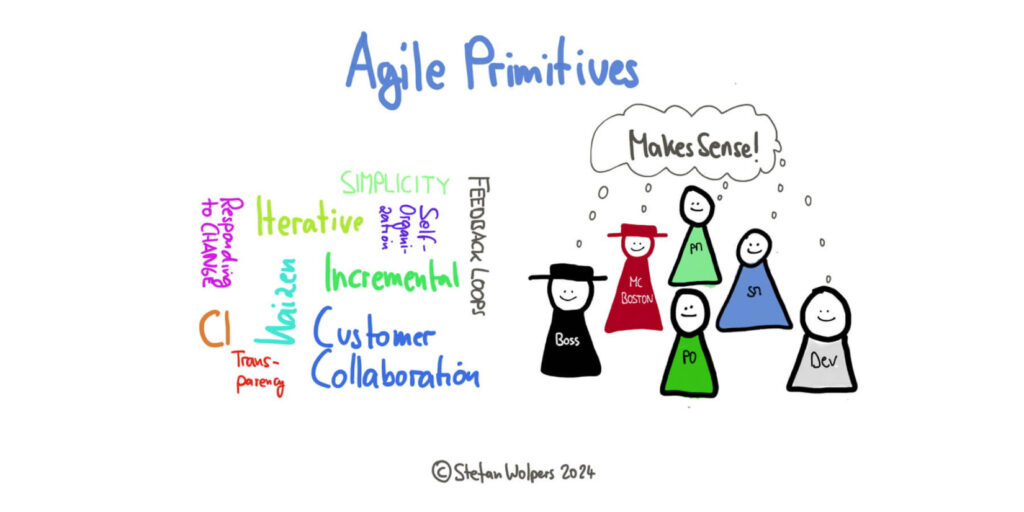TL;DR: Agile Primitives
Are we losing sight of what truly matters in Agile? The future isn’t about rigidly adhering to or outright dismissing frameworks like Scrum or SAFe. Instead, it’s about returning to the fundamental principles — the Agile Primitives — that genuinely empower teams to adapt, innovate, and deliver real value. By refocusing on these core elements, organizations can move beyond mere methodological compliance and embrace authentic agility.
Dive in to explore how the Agile community is coming full circle, rediscovering the essence that made Agile transformative in the first place.
Join the Free Hands-on Agile 2025 from February 4-6, 2025, and Talk about Agile Primitives!
HoA2025’s topic is: From Concept-Based to Context-Based Agility.
<!–
🇩🇪 Zur deutschsprachigen Version des Artikels: Founder Mode: Die dunkle Seite eines gehypten Modells.
–>
🗞 Shall I notify you about articles like this one? Awesome! You can sign up here for the ‘Food for Agile Thought’ newsletter and join 42,000-plus subscribers.
🎓 Join Stefan in one of his upcoming Professional Scrum training classes!
Agile Primitives — Ten Core Prinziples
As our understanding of agility evolves, it’s easy to get caught up in the noise of new frameworks, certifications, and buzzwords. The “agile-industrial complex” — I love that coining — has been good at creating and marketing those.
However, at its core, Agile isn’t about adhering to a particular method—it’s about embracing fundamental principles that drive adaptability, collaboration, and continuous learning. These principles, which I call the ‘Agile Primitives,’ are the building blocks of any truly agile organization. By understanding and applying these primitives, teams can cut through the clutter of rigid processes and return to what matters most: delivering value by solving their customers’ problems while contributing to their organization’s survival.
Below, we explore ten essential Agile Primitives at the heart of any successful agile practice. These are not just abstract concepts but practical, actionable principles that have stood the test of time. If you’re looking to reinvigorate your Agile approach, start by mastering these core elements:
1. Iterative Development
Detailed Description: Iterative development is a cyclical approach where the software development process is divided into small, manageable segments called iterations or sprints. Each iteration encompasses all the stages of development—planning, design, coding, testing, and evaluation—but focuses on a limited set of features or requirements. A team produces a potentially shippable product increment at the end of each cycle. This approach allows teams to refine the product progressively, incorporating feedback and adapting to changes after each iteration.
By continuously revisiting and enhancing the product, teams can uncover and address issues early, improve quality, and ensure that the product evolves in alignment with user needs and market demands. Iterative development also facilitates risk management by tackling high-risk elements in early iterations, thereby reducing uncertainty as the project progresses.
Why It’s a Primitive:: Iterative development is foundational because it establishes the rhythm and structure under which Agile practices thrive. Similar to loops in programming that allow for repeated execution of code blocks until a condition is met, iterative development enables continuous refinement and adaptation of the product. It embodies the Agile values of responsiveness and customer focus by providing regular checkpoints for feedback and adjustment.
Without iterative cycles, Agile teams would lack the essential mechanism for frequent inspection and adaptation, which is crucial for handling changing requirements and fostering continuous improvement. This principle is an Agile primitive because it is an indispensable component that supports other Agile practices, such as incremental delivery and continuous improvement.
References:
Schwaber, K., & Beedle, M. (Oct 2001). Agile Software Development with Scrum. Prentice Hall.
Larman, C. (Aug 2003). Agile and Iterative Development: A Manager’s Guide. Addison-Wesley.
2. Incremental Delivery
Detailed Description: Incremental delivery involves constructing and delivering the product in small, functional pieces rather than waiting to release a complete product at the end of the development cycle. Each increment builds upon the previous ones, adding new features or enhancements that provide value to the user. This approach allows stakeholders to receive tangible progress updates and enables the team to validate assumptions, gather user feedback, and make informed decisions for subsequent increments.
By focusing on delivering the most valuable features first, teams can ensure that the product meets the most critical customer needs early on. Incremental delivery also enhances flexibility, as a team can incorporate changes in upcoming increments without significant rework.
Why It’s a Primitive: Incremental delivery is fundamental because it operationalizes the Agile principle of delivering working software frequently.
As a primitive, incremental delivery reduces the risk of project failure by validating the product’s direction at each stage. It allows teams to adapt to changing requirements and priorities, which is vital in dynamic environments where customer needs and market conditions evolve rapidly.
References:
Beck, K., & Andres, Cynthia (Nov 2004). Extreme Programming Explained: Embrace Change. Addison-Wesley.
Poppendieck, M., & Poppendieck, T. (May 2003). Lean Software Development: An Agile Toolkit. Addison-Wesley.
3. Continuous Improvement (Kaizen)
Detailed Description: Continuous improvement, derived from the Japanese term Kaizen, is the ongoing effort to enhance products, services, or processes. In the context of Agile, it involves regularly reflecting on team performance, workflows, and outcomes to identify opportunities for enhancement. Teams often facilitate this practice through Retrospectives, where team members collaboratively analyze how they can refine their processes and improve collaboration and communication.
Continuous improvement encourages a culture of learning and adaptability. It empowers teams to experiment with new ideas, learn from failures, and implement changes that improve efficiency, quality, and customer satisfaction. By fostering an environment where feedback is valued and acted upon, teams can achieve incremental gains that cumulatively result in significant advancements.
Why It’s a Primitive: Continuous improvement is a cornerstone of Agile because it embodies the philosophy of adaptability and relentless pursuit of excellence.
As a primitive, it ensures that agile teams do not become stagnant but instead evolve with changing circumstances and learn from their experiences. This principle is essential for maintaining competitiveness and delivering high-quality products in a highly competitive market.
References:
Takeuchi, H., & Nonaka, I. (Jan-Feb 1986). “The New New Product Development Game.” Harvard Business Review, 64(1), 137–146..
Ohno, T. (Mar 1988). Toyota Production System: Beyond Large-Scale Production. Productivity Press.
Cannot see the form?
Please click here.
4. Customer Collaboration
Detailed Description: Customer collaboration emphasizes the importance of engaging customers or stakeholders throughout the development process. Rather than relying solely on contractual agreements and predefined requirements, Agile teams seek ongoing customer input and feedback. This collaboration can take various forms, such as observing customers using the product, regular meetings, demonstrations of product increments, and joint planning sessions.
By involving customers directly, teams gain a deeper understanding of their needs, preferences, and pain points. This close partnership helps build trust and ensure that the product being developed aligns with customer expectations and delivers genuine value. It also allows for rapid adjustments in response to feedback, reducing the risk of building features that do not meet user needs.
Why It’s a Primitive: Customer collaboration is fundamental because it shifts the focus from merely fulfilling a contract or job to delivering customer value by alleviating their pain points.
As a primitive, this principle ensures that Agile teams remain responsive and customer-centric. Without active collaboration, teams risk developing products in a vacuum, leading to misalignment with market needs and reduced customer satisfaction.
References:
Cockburn, A. (Oct 2006). Agile Software Development: The Cooperative Game. Addison-Wesley.
Beck, K. et al. (2001). Manifesto for Agile Software Development.
5. Self-Organizing Teams
Detailed Description: Self-organizing teams are groups where members collectively manage their work and make decisions on how best to achieve their goals. These teams are characterized by autonomy, cross-functionality, and shared responsibility. Team members collaborate to plan tasks, allocate resources, and solve problems without relying on centralized control, popularized by Taylorism.
This approach fosters a sense of ownership and accountability, encouraging team members to leverage their diverse skills and expertise. It also promotes creativity and innovation, empowering team members to experiment with new ideas and approaches. Self-organizing teams adapt more readily to changes and can respond swiftly to emerging challenges.
Why It’s a Primitive: Self-organizing teams are foundational because they embody the Agile values of empowerment and collaboration.
As a primitive, this principle is essential for creating a dynamic and responsive development environment. It enables teams to optimize their processes and workflows, increasing efficiency and effectiveness. Without self-organization, teams may become rigid, depending on a managerial level, and less capable of adapting to changing requirements or environments.
References:
Takeuchi, H., & Nonaka, I. (Jan-Feb 1986). “The New New Product Development Game.” Harvard Business Review, 64(1), 137–146..
Drucker, P. F. (May 2007). Management Challenges for the 21st Century. Harper Business.
6. Adaptability and Responding to Change
Detailed Description: Adaptability in Agile refers to the willingness and ability to embrace changes in requirements, technologies, or market conditions—even late in the development process. Agile practices prioritize responding to change over following a rigid plan, recognizing that flexibility is essential in a dynamic business environment.
Teams practicing adaptability remain vigilant to external and internal signals that may necessitate adjustments. They employ practices such as regular Backlog refinement, customer feedback sessions, and product discovery to stay aligned with current information. This approach minimizes the risk of delivering a product that is outdated or misaligned with customer needs upon release.
Why It’s a Primitive: Adaptability is fundamental because it ensures that agile teams can navigate uncertainty and complexity effectively.
As a primitive, adaptability enables teams to pivot when necessary, preserving the relevance and value of the product. It is essential for maintaining a competitive edge and ensuring that the development efforts lead to meaningful outcomes.
References:
Highsmith, J. (Jul 2009). Agile Project Management: Creating Innovative Products. Addison-Wesley.
Beck, K. et al. (2001). Manifesto for Agile Software Development.
7. Continuous Integration
Detailed Description: Continuous Integration (CI) is the practice of merging all developer changes to the main codebase frequently, often multiple times per day. Each integration is verified by an automated build and testing process, allowing teams to detect integration errors quickly and locate them more easily. CI aims to prevent integration problems, which can occur when merging changes at the end of a project or release cycle.
By integrating regularly, teams ensure that the codebase remains deployable. Automated tests validate that new changes do not break existing functionality, enhancing code quality and reliability. CI also facilitates collaboration among developers, reducing merge conflicts and encouraging communication about changes.
Why It’s a Primitive: Continuous Integration is essential because it underpins Agile’s focus on delivering working software frequently and maintaining high quality.
As a primitive, CI ensures that the development process is seamless and that the product evolves coherently. It reduces technical debt and the likelihood of defects, critical for maintaining customer trust and satisfaction.
References:
Duvall, P. M., Matyas, S., & Glover, A. (Jun 2007). Continuous Integration: Improving Software Quality and Reducing Risk. Addison-Wesley.
Fowler, M. (2006). “Continuous Integration.”
8. Transparency
Detailed Description: Transparency in Agile refers to the open and honest sharing of information among team members and stakeholders. It makes all aspects of the project—progress, challenges, plans, and changes—visible and accessible. Tools such as task boards, backlogs, a Definition of Done, or daily stand-up events facilitate transparency by providing real-time insights into the team’s work.
Transparency fosters trust and accountability, as everyone clearly understands the project’s status and any obstacles that may impede progress. It enables stakeholders to make informed decisions and provides a basis for effective collaboration. By highlighting issues early, teams can address them promptly, reducing the impact on the project’s timeline and quality.
Why It’s a Primitive: Transparency is foundational because it supports effective communication and collaboration, which are critical for Agile’s success.
As a primitive, transparency ensures all participants are aligned and working towards common goals. It reduces misunderstandings and helps prevent conflicts, enabling the team to function cohesively. Without transparency, issues may remain hidden until they become critical, jeopardizing the project’s success.
References:
Sutherland, J., & Schwaber, K. (2020). The Scrum Guide.
Liker, J. K. (Dec 2020). The Toyota Way: 14 Management Principles from the World’s Greatest Manufacturer. McGraw-Hill.
9. Feedback Loops
Detailed Description: Feedback loops are mechanisms that provide information about the results of actions taken, allowing teams to adjust their behavior or processes accordingly. In Agile, feedback loops can occur at multiple levels, including customer feedback on product increments, team reflections during Retrospectives, and automated feedback from continuous integration systems.
These loops enable teams to learn quickly from their experiences and make data-informed decisions. By shortening the time between action and feedback, teams can respond more effectively to issues, improve product quality, and enhance customer satisfaction. Feedback loops are essential for validating assumptions, discovering user needs, and ensuring the team is on the right track.
Why It’s a Primitive: Feedback loops are fundamental because they facilitate continuous learning and adaptation, core tenets of Agile practices.
As a primitive, feedback loops ensure that teams do not operate in a vacuum but remain connected to the reality of their product’s performance and user expectations. They are crucial for refining the product and the development process, leading to better outcomes.
References:
Reinertsen, D. G. (May 2009). The Principles of Product Development Flow: Second Generation Lean Product Development. Celeritas Publishing.
Deming, W. E. (Reissue Oct 2018). Out of the Crisis. MIT Press.
10. Simplicity
Detailed Description: Simplicity in Agile focuses on maximizing the amount of work not done by eliminating unnecessary complexity and concentrating on delivering only what is essential. This principle encourages teams to prioritize features and tasks based on value and to avoid over-engineering solutions. Simplicity applies to code, design, processes, and communication, advocating for clear, straightforward approaches.
By embracing simplicity, teams can reduce development time, lower costs, and minimize potential defects. It helps prevent scope creep and ensures that resources are focused on delivering the highest-value items. Simplicity also makes the product easier to maintain and extend in the future.
Why It’s a Primitive: Simplicity is fundamental because it enhances efficiency and effectiveness, key goals of Agile methodologies. It is similar to the KISS principle (“Keep It Simple, Stupid”) in programming and design, which advises against unnecessary complexity.
As a primitive, simplicity ensures that teams remain focused on delivering value without being sidetracked by non-essential tasks. It supports other Agile principles by enabling faster iterations, easier adaptability, and improved collaboration. Without simplicity, projects risk becoming unwieldy and difficult to manage, undermining Agile’s benefits.
References:
Beck, K., & Andres, Cynthia (Nov 2004). Extreme Programming Explained: Embrace Change. Addison-Wesley.
Cohn, M. (Mar 2004). User Stories Applied: For Agile Software Development. Addison-Wesley.
Agile Primitives: Food for Thought
As you reflect on the Agile Primitives outlined above, consider how they manifest within your organization or projects. Are these foundational principles genuinely embedded in your team’s practices, or have they been overshadowed by rigid adherence to specific frameworks? Challenge yourself to think about the following:
Reevaluate Your Approach: Is your team following Agile principles or merely going through the motions of a framework? Examine whether processes have become ends in themselves rather than means to deliver value.
Foster a Culture of Learning: Are you encouraging continuous improvement and learning within your team? Consider supporting a failure culture to entice learning and create psychological safety, as failure is inevitable in a complex environment.
Engage with Stakeholders: How actively are you collaborating with customers and stakeholders? Seek opportunities to enhance this collaboration to ensure that you’re meeting real needs.
Simplify and Focus: Are there complexities in your processes that can be eliminated? Strive for simplicity to enhance effectiveness and reduce waste.
By critically assessing these questions, you may uncover opportunities to deepen your agile practice, moving beyond frameworks to embrace the core principles that drive true agility.
Conclusion — Agile Primitives
It’s time we strip away the layers of dogma that have accumulated around frameworks like Scrum and SAFe. The discontent we’re witnessing isn’t about the frameworks per se but what occurs when practices become mindless prescriptions. We’ve been so engrossed in following methodologies to the letter that we’ve lost sight of the essence—the Agile Primitives—that potentially make these frameworks effective in the first place.
By refocusing on these foundational elements—iterative development, incremental delivery, continuous improvement, customer collaboration, self-organizing teams, adaptability, continuous integration, transparency, feedback loops, and simplicity—we reconnect with the core principles that empower teams to navigate complexity and deliver real value. These Agile Primitives aren’t just theoretical ideals; they’re practical guides that require commitment and a willingness to challenge entrenched processes.
Embracing the Agile Primitives doesn’t mean throwing out all frameworks and starting from scratch. Instead, it means using frameworks as flexible tools rather than rigid rulebooks. It’s about fostering a culture where teams are empowered to adapt practices to their unique contexts, always with an eye on the underlying principles that drive success. The Agile community is indeed coming full circle, returning to the heart of what agility truly means: a relentless focus on delivering value through continuous learning, adaptation, and improvement. Let’s not lose sight of what really matters.
Agile Primitives — Recommended Reading
<!–
–>
👆 Stefan Wolpers: The Scrum Anti-Patterns Guide (Amazon advertisement.)
📅 Scrum Training Classes, Workshops, and Events
You can secure your seat for Scrum training classes, workshops, and meetups directly by following the corresponding link in the table below:
Date
Class and Language
City
Price
🖥 💯 🇬🇧 October 9, 2024
GUARANTEED: Hands-on Agile #65: The Lean Tech Manifesto with Fabrice Bernhard (English)
Live Virtual Meetup
FREE
🖥 💯 🇬🇧 October 15-16, 2024
GUARANTEED: Professional Scrum Master Advanced Training (PSM II; English; Live Virtual Class)
Live Virtual Class
€1.299 incl. 19% VAT
🖥 🇩🇪 November 6-7, 2024
Professional Scrum Product Owner Training (PSPO I; German; Live Virtual Class)
Live Virtual Class
€1.299 incl. 19% VAT
🖥 🇬🇧 November 18-19, 2024
Professional Scrum Master Advanced Training (PSM II; English; Live Virtual Class)
Live Virtual Class
€1.299 incl. 19% VAT
🖥 🇬🇧 November 21, 2024
Professional Scrum Facilitation Skills Class (PSFS; English; Live Virtual Class)
Live Virtual Class
€749 incl. 19% VAT
🖥 🇩🇪 December 4-5, 2024
Professional Scrum Master Training (PSM I; German; Live Virtual Class)
Live Virtual Class
€1.189 incl. 19% VAT
🖥 🇩🇪 December 10-11, 2024
Professional Scrum Product Owner Training (PSPO I; German; Live Virtual Class)
Live Virtual Class
€1.299 incl. 19% VAT
🖥 🇬🇧 December 18-19, 2024
Professional Scrum Master Advanced Training (PSM II; English; Live Virtual Class)
Live Virtual Class
€1.299 incl. 19% VAT
See all upcoming classes here.
You can book your seat for the training directly by following the corresponding links to the ticket shop. If the procurement process of your organization requires a different purchasing process, please contact Berlin Product People GmbH directly.
✋ Do Not Miss Out and Learn more about Agile Primitives — Join the 20,000-plus Strong ‘Hands-on Agile’ Slack Community
I invite you to join the “Hands-on Agile” Slack Community and enjoy the benefits of a fast-growing, vibrant community of agile practitioners from around the world.
If you like to join all you have to do now is provide your credentials via this Google form, and I will sign you up. By the way, it’s free.
Support your team’s efforts with Agile Primitives by pointing to the free Scrum Anti-Patterns Guide:
The post Agile Primitives — Beyond Frameworks appeared first on Age-of-Product.com.





